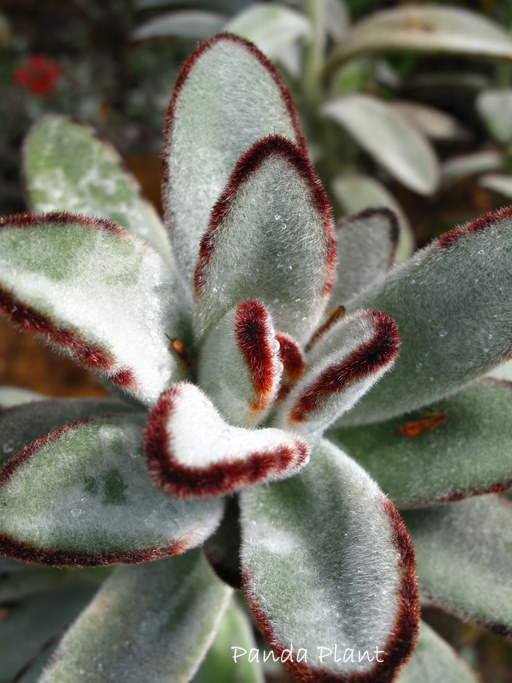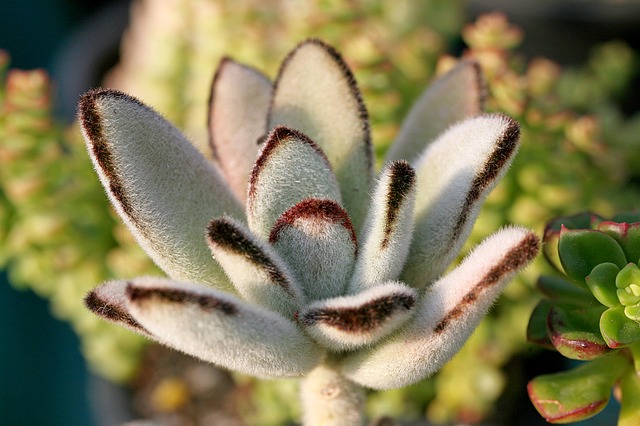Panda Plant Indoor Care
Thick, soft, furry leaves give Panda Plant its common name. Other names for this succulent, known botanically as Kalanchoe tomentosa, are Pussy Ears and Chocolate Soldier.
It's not only eye-catching, this is one of the easiest succulent houseplants to grow. Find out how to water and fertilize, when to repot, plus how to start a plant cutting.

Get to Know Panda Plant
Branching from the central stem, the plump, rounded leaves taper to a point. Leaves are about 1- to 3-inches long, and silvery green marked with reddish-brown edges. The "fur" is actually soft, fine hair that covers these succulent plants.
Panda Plant will eventually grow side branches, forming a small shrub. It is slow-growing and will take a few years to reach its mature height of around 1 ft (30 cm).
In its native habitat of Madagascar, Panda Plant produces fuzzy, bell-shaped flowers in spring and summer. However, it rarely flowers indoors.
Decorative year-round, it makes a beautiful addition to a succulent dish garden. Like other succulent types, it stores water in its leaves so it rarely needs watering.
And like other types of succulents, Kalanchoe tomentosa is tolerant of dry air. It makes a good house plant for heated homes. Just give it plenty of light and it'll thrive for many years.
Is panda plant poisonous? Yes. According to the ASPCA, Kalanchoe tomentosa is toxic to cats and dogs. Kalanchoe spp. contain Bufodienolides, which may cause vomiting, diarrhea, and (rarely) abnormal heart rhythm.
We are family
Kalanchoe tomentosa is in the Crassulaceae family.
Kalanchoe is a genus that includes more than 100 species of succulent plants. The most popular for growing indoors is flowering Flaming Katy (Kalanchoe blossfeldiana).
Panda Plant Problems, Solutions and Answers
Water carefully. Avoid getting the furry leaves of this plant wet because they'll easily rot. Water from the bottom or water the potting mix. If the leaves need to be cleaned, brush them gently with a soft, dry brush, such as a small paintbrush.
Leggy plants (tall stems with long spaces between leaves) are a sign the plant needs more sunlight. Move to a sunny window.
Repot in spring, only when it's outgrowing its pot. Move Panda Plant to a container only 1- to 2-inches (2.5 to 5 cm) larger. Pots that are too big will hold too much water for this succulent. Also be sure to use a pot with a drainage hole. If you want to cover up a plain nursery pot, slip it into a cachepot (a decorative container without holes). It's a good idea to put some pebbles in the bottom of the cachepot to keep the nursery pot above the drainage water.
Something bugging your plant? Watch for mealybugs. They look like white, fuzzy patches, and tend to cluster at the base of the leaves or along the stems. Remove them with a cloth or cotton swab dipped in rubbing alcohol.
 Eye-catching Panda Plant makes an excellent houseplant. Photo credit: manseok Kim
Eye-catching Panda Plant makes an excellent houseplant. Photo credit: manseok KimPanda Plant Care Tips
Origin: Madagascar
Height: Up to 1 ft (30 cm) when grown indoors
Light: Bright light to full sun. Put this succulent in a bright location year-round. If you move it outdoors for the warm months, move it gradually to a sunny location to avoid scorching its leaves.
Water: Water thoroughly, allowing the top 1 in (2.5 cm) to dry out between waterings. Take care not to get the fuzzy leaves wet because they can rot. Use a pot with a drainage hole to prevent soggy potting mix.
Humidity: Average room humidity (around 40% relative humidity).
Temperature: Average room temperatures 65-75°F/18-24°C. If you move Kalanchoe tomentosa outdoors, don't worry -- it can take intense heat. However, it won't tolerate frost and may be damaged by temps less than 40°F/4°C.
Soil: Cactus potting mix provides fast drainage, which this succulent requires.
Fertilizer: Feed monthly in spring and summer with a fertilizer specially made for succulent plants.
Propagation: Take leaf cuttings from Panda Plant in spring or early summer. Succulent cuttings root easily in moist sandy mix or perlite.

